Sensible advertising measures
"God has an awareness level of over 98%. And yet (or precisely because of this) he rings the church bells every Sunday ..."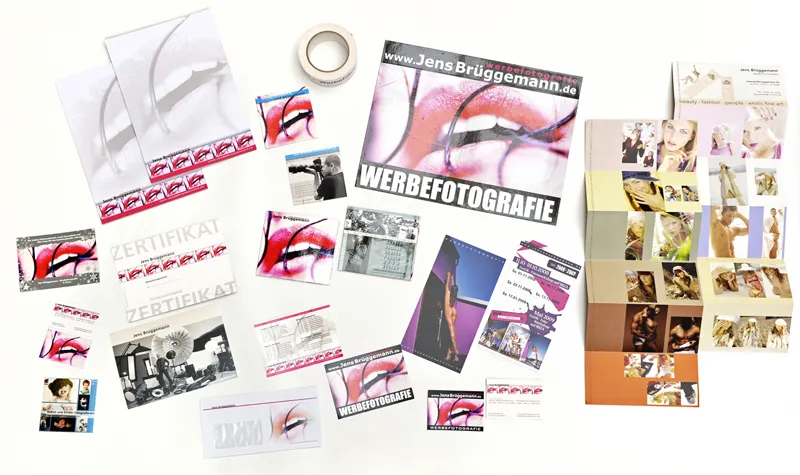
Being a good photographer alone is not enough to get many orders. Advertising is necessary to attract the attention of potential customers. In this photo I have put together some of my advertising measures from the last few years: Parcel tape, car magnet sign, flyer, postcard, Christmas card, writing pad, CD cover, sticker, workshop appointment flyer, etc. There are many ways to attract attention! Layouts by: L.I.Design, Handwerk-Media, Brüggemann
Exhibitions with free works are also a good way to attract attention. However, make sure that the vernissage and finissage are sufficiently announced in the press so that the exhibition is well attended. It is also advisable to display additional flyers (with some of your works printed on them, your CV and contact details) in a clearly visible place so that visitors will remember you in the long term.
Targeted advertising
However, before you get started with your advertising, it is important to think carefully about who your advertising is aimed at. Who is the target audience, who do you want to reach? Or, in other words, who do you want your potential clients to be in the future? After all, it makes no sense to distribute flyers in a shopping center if you only intend to work for well-known companies and advertising agencies (i.e. "B2B"). The situation is different if you offer passport photos, wedding reportages and family photos. In this case, it may make sense to hand out flyers and possibly a price list to visitors to a large shopping center.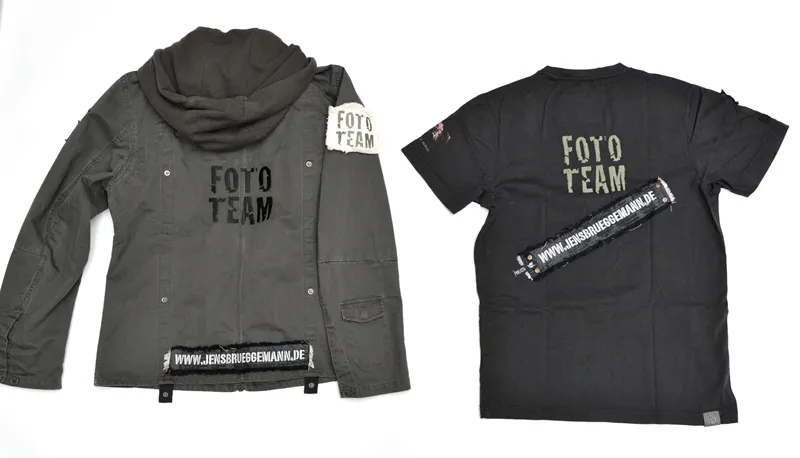
There are many ways to attract attention. These self-designed garments have already attracted attention several times when I have taken photographs in public.
Flyers and brochures with examples of my work are a good way to attract attention. These are the front and back of my current self-promotion.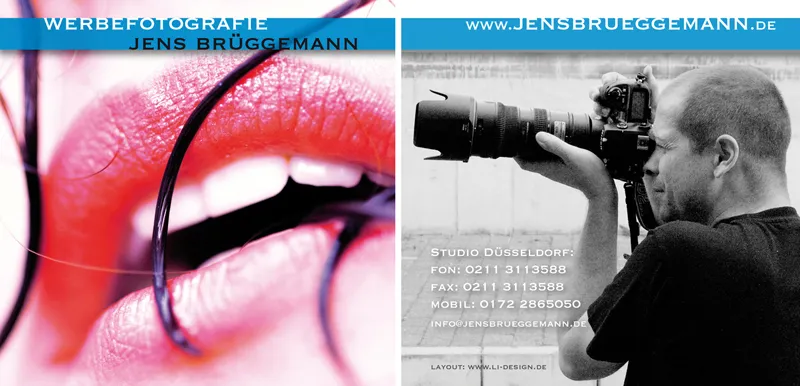
Let's come back to our example above. Photographer F. has her own portrait studio near a large shopping center. She offers passport photos, wedding portraits and family photos, and during the Christmas season, some of her customers also take nude photos as Christmas presents for their loved ones. Since her portrait studio is only a 2-minute walk from the shopping center, she would like to hand out a flyer with great photo examples to passers-by. She has commissioned 2 students, her niece and her niece's friend, to do this. Are they allowed to hand out photographer F's advertising in the shopping center just like that?
No, they cannot simply distribute the flyers unannounced. The operator has the right of domicile in the shopping center, and he will not readily agree to you distributing advertising there; after all, some passers-by could simply carelessly throw away your advertising after a brief skim and thus litter the shopping center. Your distribution campaign must therefore be registered with the operator of the shopping center, i.e. you will also have to pay a more or less high fee if you want to get permission to do so.
The same applies if you want to distribute flyers at a city festival. If the public order office catches you or your representatives distributing your advertising unannounced, you will have to pay a hefty fine and probably face charges. It is therefore better to ask those responsible beforehand and save yourself unnecessary trouble.
However, before you quickly sit down at your computer and order flyer advertising from an online printing company, find out in advance how much it costs to get permission to distribute flyers at a city festival. I once had a customer who had ten thousand flyers printed that he wanted to have distributed at a city festival, but after finding out about the amount of the concession (5,000 euros!), he had them scrapped ...
As you have seen from the previous comments, the problem is not the layout and the production of suitable advertising material, but its distribution. Thanks to Internet printing companies such as Flyerpilot or Flyeralarm and many others, the cost of flyers and other printed materials has fallen significantly in recent years.
For example, in December 2010, 5000 flyers (135g/sqm paper, glossy image printing, postcard size, printed on both sides) cost just 29.86 euros net (= 35.53 euros gross) at an online print shop! It really doesn't get any cheaper than that! That's just a little more than half a cent per flyer. But regardless of the production costs, the flyers also have to find their way to the recipient.
So they have to be distributed (for example in a shopping center) or displayed (in a store or at an exhibition) or sent (for example by post). And that's where the costs arise!
I distributed this flyer at Photokina in the fall of 2008, where I photographed models for Nikon on their stage for several days and presented the then newly released D3. The target group was dedicated photographers, i.e. the very Photokina audience that came to the Nikon stand and watched me at the photo shoots.
Business cards
Business cards are a highly efficient means of professional self-promotion, not only, but especially for photographers. While the front contains your name, job title, address, telephone and fax number, web and e-mail address, the back has space for a representative photo of one of your main photographic themes. If you don't have a studio, don't give an address either. Or at best an office address, but never your home address! It is not unusual to use the job titles "photo designer", "photographer", "advertising photographer", "wedding photographer", "press photographer", "photojournalist", "portrait studio", etc. However, you should avoid empty phrases such as "art and photo", "hobby photographer", "photographic art for all", "master photographer", etc. The term "photographer" is not protected and can therefore be used. The term "master photographer" may not be used, as only photographers who have passed the corresponding master examination may advertise with this title.
There is space for exactly one photo on the back. Even if you have good eyes, you should not use more; a single eye-catching photo is enough! No one will expect you to showcase your entire photographic range on your business card.
Pictured here is my current business card. The sensually open mouth as a symbol of modern eroticism has been my logo for almost two years. The front of the business card also roughly reflects the layout of my website.
However, I was horrified when a colleague, a photographer for beauty, portrait and family photos, handed me her (flabby) business card, which not only looked like it had been printed out on her own printer, but - even worse! - on the back showed two young women who were not photographed (by her), as you would expect, but drawn by a graphic artist! What a poor opinion this photographer must have of her skills to advertise with a drawing ...!
Internet presence
The most important advertising medium for photographers, both now and in the future, is the Internet. With your own website, you can present your own work efficiently and without obligation, and provide information about contact options, services offered, prices, promotions, publications, references, exhibitions, etc.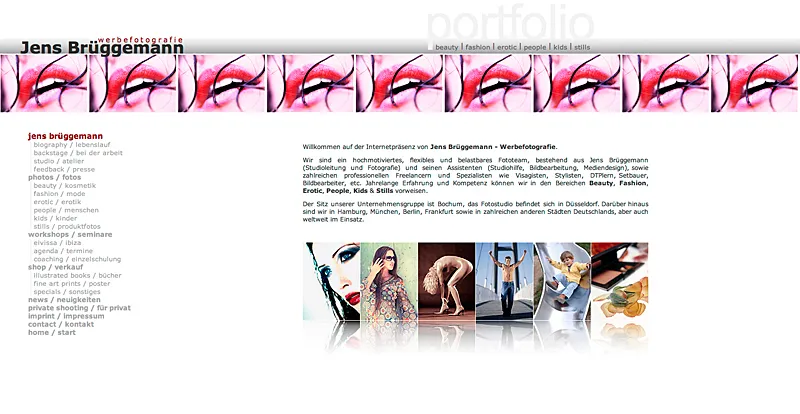
This screenshot shows my current website. For me, my website is the simplest, but also the most effective platform for presenting my photographic work. However, it requires a great deal of maintenance, as I have to update my website almost every week, upload new photos and delete old ones. A news section provides information about new publications, and changes in the store area also have to be taken into account.
The Internet has therefore become an indispensable part of every photographer's self-presentation. Anyone who is not yet represented on the Internet with their own website, but would like to earn a living as a photographer in the near future, should therefore stop reading at this point and immediately commission their own website, i.e. first secure the domain (which should be as easy to remember as possible). You can check whether the desired domain name is still available at the providers where the domain is ordered and at the following address: http: //www.denic.de/domaincheck.html. When choosing a domain name, however, you must ensure that you do not infringe any third-party name, trademark or company rights.
When creating your own website, you must ensure that an imprint that is "easily recognizable, directly accessible and permanently available" (Section 5 TMG) contains the following points if you do not want to run the risk of being warned for a fee (see Section 5 of the German Telemedia Act TMG):
- Full name, with first name written out in full
- the company name for merchants
- A summonable address (no P.O. Box address!)
- Telecommunication data such as telephone, fax, email
- in the case of corporations, the name of the managing director, the relevant commercial register and the registered office of the company
- the VAT identification number, if you have one.
If you want to present commissioned photos that you have taken for customers on your website, make sure that you have the permission of the customer on whose behalf the photo was taken.
If you are planning to link to other websites or web content, find out in advance exactly how this can best be done without infringing copyrights or running the risk of being held liable for the content of other sites. A blanket disclaimer, for example in the legal notice or on the homepage, is not enough! Guestbook entries can also be problematic and should only be approved after checking if you do not want to do without a guestbook completely. In general, every operator of a website is legally responsible for all content that is made available for retrieval.
The photos on my website are all provided with a watermark. Even if this method does not offer 100% protection against misuse, it does signal that the author (i.e. me) takes his moral rights seriously. In addition, I only present the photos on my website in low resolution.
Window dressing
Established photographers who focus on portrait, family and wedding photography will usually work in a store, preferably in a pedestrian zone, shopping street or shopping center. Ideally, the store should have one or more large shop windows. Here you can effectively present your best work to the passing public and draw the attention of passers-by to your work. If your customers (the "walk-in customers") come from the town where the store is located, a shop window with appropriate decoration is even more important than your own website.
This makes it clear that you change the decoration regularly, preferably every two to three weeks. In addition to the work from the bread-and-butter store, also present unusual items. You will quickly notice which photos in the shop window lead to new customer contacts and which do not.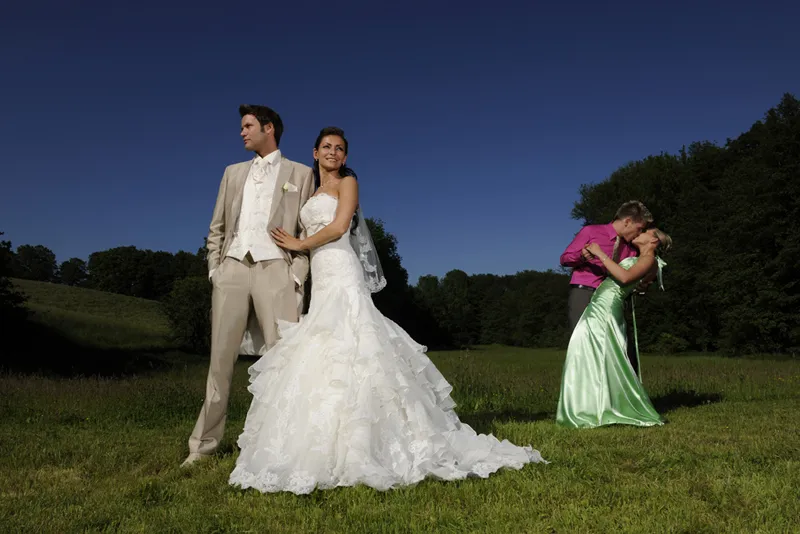
Eye-catching photos displayed in the shop window, such as this colorful wedding photo, are a good way to arouse the curiosity of potential customers. Incidentally, wedding photos are one of the most important revenue generators in the day-to-day business of established photographers.
But don't be satisfied with just regularly displaying your best photos; price information, information on current offers and the presentation of photo articles (e.g. photos on coffee cups, T-shirts or mouse pads, as a puzzle or in a self-designed photo book, on calendars, etc.) also belong in the shop window. A well-decorated shop window attracts customers from a distance and informs them when they are standing right in front of it.
Acquisition from advertising agencies and publishers
If a (successful) initial contact (e.g. after a mailing) leads to an interview with an advertising agency, a publishing house or the marketing department of a company, you will be expected to bring selected works for presentation, even if the other person has already visited your website and - in fact - already knows most of your work.
"Selected work" should be taken quite literally in this context, as you are expected to have already tailored the presentation to the needs of your counterpart at the interview. So it doesn't help to present great people shots when it comes to being awarded a product photo shoot. Photographers with sufficient self-confidence often take the view that they will also achieve good results in other areas of photography than just their area of focus. This may be true in most cases. However, almost all people, including art buyers of course, have internalized this pigeonhole thinking, so that photographers are regularly booked for certain jobs who have already photographed the exact subject under discussion in the past.
Behind this is quite simply the principle of risk minimization, because it is understandably assumed that the shoot will run more smoothly if the photographer commissioned has already successfully completed such a task once (or preferably several times) in the past.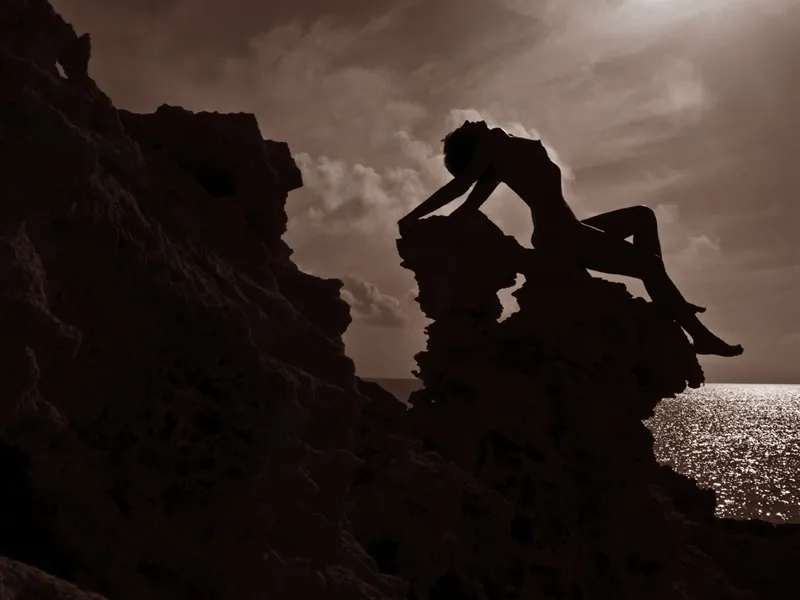
A beautiful nude photo, certainly. But if you are specifically applying to photograph machine parts, you probably have more suitable work in your portfolio. Remember that time is short, especially for art buyers. Therefore, only present a small selection of your work that fits the theme.
The form in which you present your work in a personal meeting should not really be important. The easiest way is to use a laptop, also with regard to the individual composition of the works, aligned to the needs of the client. The iPad or other tablet PCs are also predestined for this and are clearly the presentation medium of the future.
However, we also hear time and again that art buyers in particular, who are already sitting in front of a screen all day anyway, are sometimes happy to present their work in the traditional way in a classic portfolio.
Also bear in mind that the portfolio viewing appointment is not just about getting to know your work, but also about finding out whether your counterpart can imagine a (temporary) collaboration with you!
I've often had the impression that when I've shown up with my portfolio at presentation appointments, my conversation partners were only interested in collecting (stealing) ideas and not in commissioning a photo shoot.
If you have any concerns about this, it's better to break off the conversation or at least not give any detailed information.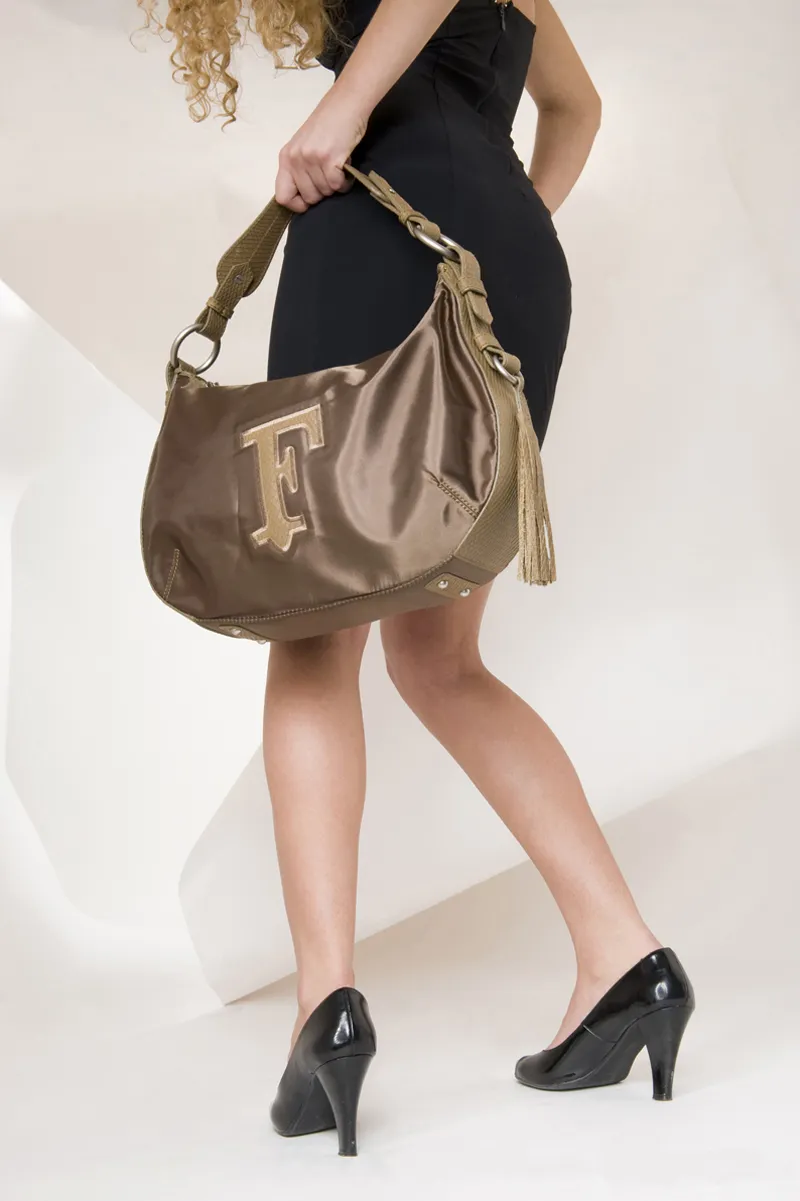
Regardless of how the conversation goes, whether you get the job or not - you should leave the art buyer with a small reminder (ideally a small image brochure of yourself) so that you are not forgotten and so that you may be shortlisted again for another job.


